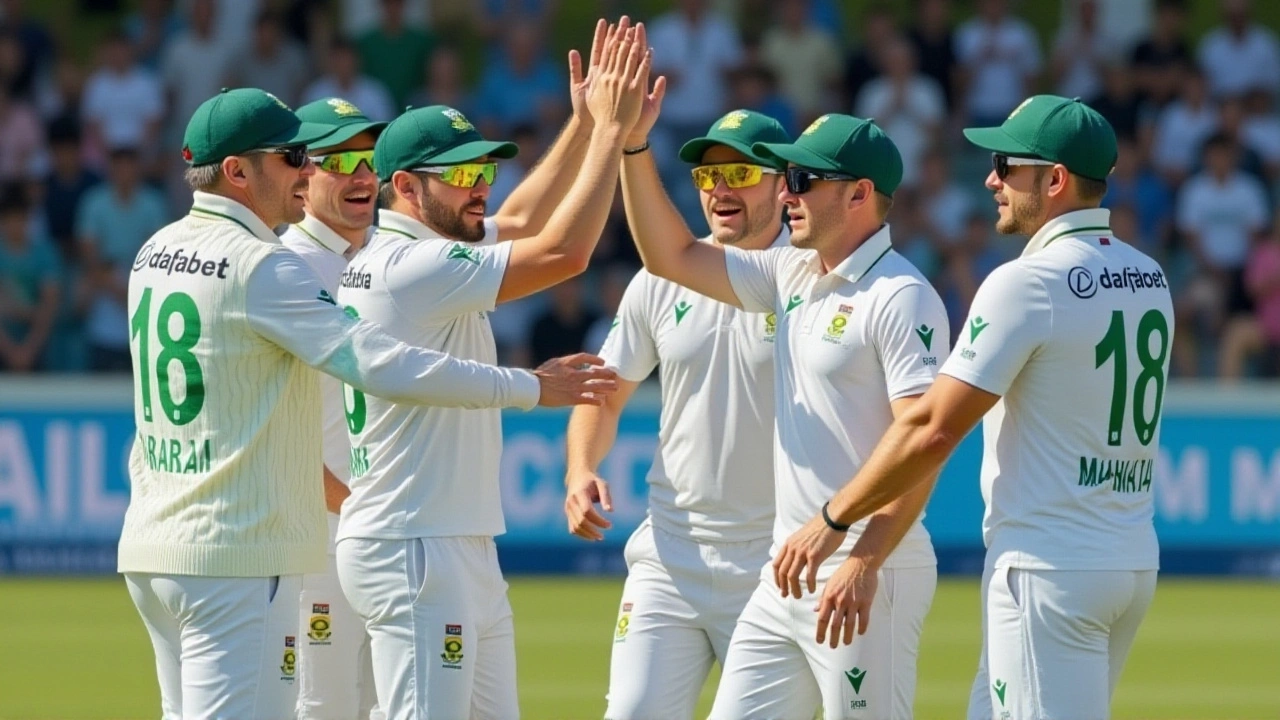When South Africa wrapped up the second Test against Zimbabwe on July 10, 2025, at Queens Sports Club in Bulawayo, they didn’t just win — they rewrote history. The Proteas completed a dominant 2-0 series sweep, outclassing a determined but outgunned Zimbabwean side in both matches, which ended within three days each. The victory wasn’t just about results; it was a coming-of-age moment for a new generation of South African cricketers, and a record-shattering display from their captain, Wiaan Mulder, who smashed 312 runs — surpassing Hashim Amla’s 311* to become the highest individual scorer in Test cricket for South Africa.
A New Era Begins in Bulawayo
The first Test, played from June 28 to July 2, set the tone. Keshav Maharaj, at 34, led South Africa in his first Test captaincy and marked the occasion by taking his 200th Test wicket — the first South African spinner ever to reach that milestone. But the real story was the debutants. Lhuan-dre Pretorius, just 19, became the youngest South African to score a Test century and the youngest cricketer globally to reach 150 runs in a Test innings. His 152 not only stunned the crowd but signaled a seismic shift in the Proteas’ batting pipeline. Dewald Brevis and Codi Yusuf also made their Test debuts, while Corbin Bosch delivered a surprise all-round masterclass: 107 with the bat and 4/38 with the ball in Zimbabwe’s second innings.Mulder’s Masterpiece and the Record That Shattered
The second Test, from July 6 to July 10, was even more astonishing. Zimbabwe won the toss and chose to field — a decision that backfired spectacularly. Wiaan Mulder walked in at 45/2 and never looked back. He batted for over 10 hours, facing 488 balls, hitting 38 fours and 10 sixes. His 312 not only broke Amla’s 12-year-old record but also made him the first South African to reach 1,000 Test runs in fewer than 15 innings. He didn’t just score runs — he dismantled psychological barriers. Zimbabwe’s bowlers, including veteran Craig Ervine (who bowled 24 overs), looked exhausted by lunch on day two.Zimbabwe’s reply was a textbook case of how not to face a dominant side. Their first innings collapsed to 170 in just 43 overs. Sean Williams, at 38, fought valiantly with 83 off 55 balls — his highest Test score since 2022 — but the rest crumbled. Prenelan Subrayen and Codi Yusuf tore through the top order. In the second innings, Zimbabwe fought harder, but Mulder’s knock had already broken their spirit. They were bowled out for 220, with Corbin Bosch again leading the charge (4/38), and Senuran Muthusamy adding 3 wickets. South Africa won by 236 runs.
Zimbabwe’s Struggle and the Road Ahead
Zimbabwe’s squad, led by 39-year-old captain Craig Ervine, showed grit but lacked depth. Their top order, including 24-year-old Clive Madande and 26-year-old Takudzwanashe Kaitano, failed to build partnerships. Prince Masvaure was brought in as a concussion substitute in the first Test — a sign of the squad’s thin bench. The team’s last Test series, a draw against Bangladesh in April, had raised hopes, but this was a harsh reality check.Historically, South Africa has dominated this fixture: 8 wins in 9 Tests, with just one draw. This sweep extends that legacy. But for Zimbabwe, the pain is part of a longer journey. Their 2025-26 schedule is packed — hosting Sri Lanka in August, the T20 World Cup Africa Regional Final in September, Afghanistan in October, and a tour to Pakistan in November. The question isn’t whether they can compete — it’s whether they can survive long enough to build.
What This Means for South Africa
This series was South Africa’s first Test assignment since their stunning 2025 World Test Championship final win over Australia. It wasn’t just a warm-up — it was a statement. The emergence of Pretorius (19), Yusuf (24), and Subrayen (32) suggests a deep, young talent pool. Wiaan Mulder isn’t just a batsman anymore — he’s a leader. His triple century came under pressure, on a slow pitch, against a team fighting for pride. That’s the mark of a future captain.For the first time since the retirement of AB de Villiers, South Africa has a genuine, homegrown star who can carry the team into the next decade. And with Zimbabwe Cricket already planning a tri-nation T20I series with New Zealand after this Test, the Proteas are clearly being positioned as the region’s standard-bearers.
What’s Next?
South Africa’s next challenge? A high-stakes home series against India in October 2025. But first, they’ll play three T20Is against Zimbabwe and New Zealand in Bulawayo — a chance to give younger players like Lesego Senokwane and Kundai Matigimu (both Test debutants in the second Test) more exposure. For Zimbabwe, the T20 World Cup qualifiers in September are make-or-break. They need results, not just effort.Frequently Asked Questions
How did Wiaan Mulder’s 312 compare to other South African Test centuries?
Mulder’s 312 broke Hashim Amla’s previous record of 311*, set against England in 2012. It’s the highest individual score by a South African in Test history, surpassing even Jacques Kallis’ 224 and Gary Kirsten’s 275*. Mulder reached 1,000 Test runs in just 14 innings — faster than any other South African. His innings lasted 10 hours and 12 minutes, the longest by a Protea since AB de Villiers’ 307 in 2015.
Why was Lhuan-dre Pretorius’ century so historic?
At 19 years and 112 days, Pretorius became the youngest South African to score a Test century, beating the previous record held by Graeme Pollock since 1965. He’s also the youngest cricketer ever to reach 150 runs in a Test innings, surpassing Pakistan’s Mohammad Ashraful (1998). His innings came on a difficult pitch, against a disciplined attack, proving he can handle pressure — a rare trait for a teenager.
What impact did Keshav Maharaj’s 200th wicket have on South African cricket?
Maharaj became the first South African spinner to take 200 Test wickets, joining an elite global group that includes Muttiah Muralitharan and Ravichandran Ashwin. His achievement ends decades of reliance on pace bowling in South African cricket. At 34, he’s now the senior statesman of the attack — and his leadership in the first Test showed he can guide a young team through pressure situations.
How did Zimbabwe’s squad compare to South Africa’s depth?
Zimbabwe fielded 15 players across two Tests, with multiple debutants like Kundai Matigimu and Lesego Senokwane, but lacked experienced middle-order batsmen. Their top five averaged just 21.4 in the series. South Africa, by contrast, had 12 players with over 10 Test caps, plus seven debutants who all contributed meaningfully. The gap in experience and depth remains stark — and highlights the financial and developmental challenges facing Zimbabwe Cricket.
Where could fans watch the series live?
The series was broadcast live on SuperSport and DStv in South Africa, and on ZBC and SuperSport in Zimbabwe. In India, where cricket interest is massive, the matches were streamed exclusively on FanCode — no TV broadcast was available. Play started daily at 1:30 PM IST, aligning with peak viewing hours in the subcontinent, signaling growing commercial interest in Zimbabwean cricket.
What’s next for Zimbabwe’s cricket team?
Zimbabwe’s 2025-26 schedule is packed: they host Sri Lanka for 2 ODIs and 3 T20Is from August 29, then compete in the T20 World Cup Africa Regional Final in September. After that, they face Afghanistan in a full-format series (2 Tests, 3 ODIs, 3 T20Is) and travel to Pakistan for limited-overs games. Their survival in international cricket hinges on winning at least one of these series — or risk losing their Test status in the next ICC review.





